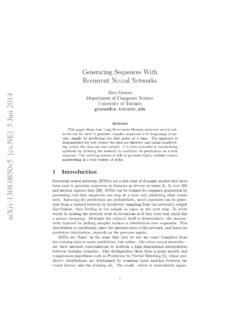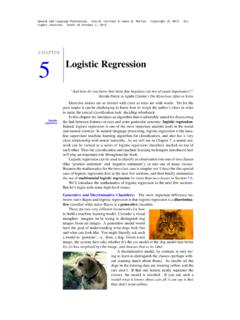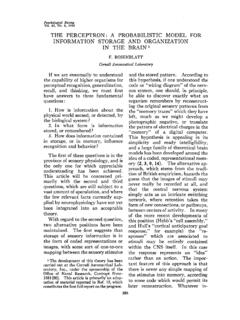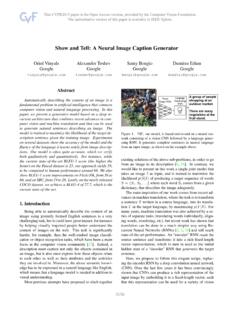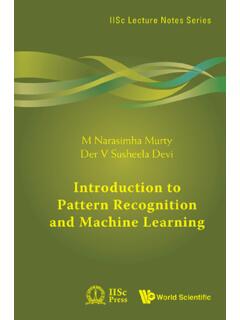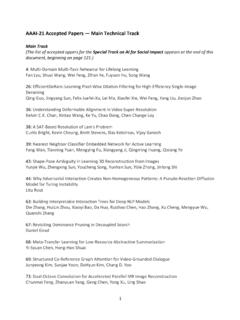Transcription of Representation Learning: A Review and New Perspectives
1 1 Representation Learning: A Review and NewPerspectivesYoshua Bengio , Aaron Courville, and Pascal Vincent Department of computer science and operations research, U. Montreal also, Canadian Institute for Advanced Research (CIFAR)FAbstract The success of machine learning algorithms generally depends ondata Representation , and we hypothesize that this is because differentrepresentations can entangle and hide more or less the different ex-planatory factors of variation behind the data. Although specific domainknowledge can be used to help design representations, learning withgeneric priors can also be used, and the quest for AI is motivatingthe design of more powerful Representation -learning algorithms imple-menting such priors.
2 This paper reviews recent work in the area ofunsupervised feature learning and deep learning, covering advancesin probabilistic models, auto-encoders, manifold learning, and deepnetworks. This motivates longer-term unanswered questions about theappropriate objectives for learning good representations, for computingrepresentations ( , inference), and the geometrical connections be-tween Representation learning, density estimation and manifold Terms Deep learning, Representation learning, feature learning,unsupervised learning, Boltzmann Machine, autoencoder, neural nets1 INTRODUCTIONThe performance of machine learning methods is heavilydependent on the choice of data Representation (or features)on which they are applied.
3 For that reason, much of the actualeffort in deploying machine learning algorithms goes into thedesign of preprocessing pipelines and data transformations thatresult in a Representation of the data that can support effectivemachine learning. Such feature engineering is important butlabor-intensive and highlights the weakness of current learningalgorithms: their inability to extract and organize the discrimi-native information from the data. Feature engineering is a wayto take advantage of human ingenuity and prior knowledge tocompensate for that weakness. In order to expand the scopeand ease of applicability of machine learning, it would behighly desirable to make learning algorithms less dependenton feature engineering, so that novel applications could beconstructed faster, and more importantly, to make progresstowards Artificial Intelligence (AI).
4 An AI must fundamentallyunderstand the world around us, and we argue that this canonly be achieved if it can learn to identify and disentangle theunderlying explanatory factors hidden in the observed milieuof low-level sensory paper is aboutrepresentation learning, , learningrepresentations of the data that make it easier to extract usefulinformation when building classifiers or other predictors. Inthe case of probabilistic models, a good Representation is oftenone that captures the posterior distribution of the underlyingexplanatory factors for the observed input. A good representa-tion is also one that is useful as input to a supervised the various ways of learning representations, this paperfocuses on deep learning methods: those that are formed bythe composition of multiple non-linear transformations, withthe goal of yielding more abstract and ultimately more useful representations.
5 Here we survey this rapidly developing areawith special emphasis on recent progress. We consider someof the fundamental questions that have been driving researchin this area. Specifically, what makes one Representation betterthan another? Given an example, how should we compute itsrepresentation, perform feature extraction? Also, what areappropriate objectives for learning good representations?2 WHY SHOULD WE CARE ABOUT LEARNINGREPRESENTATIONS? Representation learning has become a field in itself in themachine learning community, with regular workshops at theleading conferences such as NIPS and ICML, and a newconference dedicated to it, ICLR1, sometimes under the headerofDeep LearningorFeature Learning.
6 Although depth is animportant part of the story, many other priors are interestingand can be conveniently captured when the problem is cast asone of learning a Representation , as discussed in the next sec-tion. The rapid increase in scientific activity on representationlearning has been accompanied and nourished by a remarkablestring of empirical successes both in academia and in , we briefly highlight some of these high Recognition and Signal ProcessingSpeech was one of the early applications of neural networks,in particular convolutional (or time-delay) neural recent revival of interest in neural networks, deep learning,and Representation learning has had a strong impact in thearea of speech recognition, with breakthrough results (Dahlet al.)
7 , 2010; Denget al., 2010; Seideet al., 2011a; Mohamedet al., 2012; Dahlet al., 2012; Hintonet al., 2012) obtainedby several academics as well as researchers at industrial labsbringing these algorithms to a larger scale and into example, Microsoft has released in 2012 a new versionof their MAVIS (Microsoft Audio Video Indexing Service)1. International Conference on Learning Representations2. See Bengio (1993) for a Review of early work in this [ ] 23 Apr 20142speech system based on deep learning (Seideet al., 2011a).These authors managed to reduce the word error rate onfour major benchmarks by about 30% ( from on RT03S) compared to state-of-the-art models basedon Gaussian mixtures for the acoustic modeling and trained onthe same amount of data (309 hours of speech).
8 The relativeimprovement in error rate obtained by Dahlet al.(2012) on asmaller large-vocabulary speech recognition benchmark (Bingmobile business search dataset, with 40 hours of speech) isbetween 16% and 23%. Representation -learning algorithms have also been appliedto music, substantially beating the state-of-the-art in poly-phonic transcription (Boulanger-Lewandowskiet al., 2012),with relative error improvement between 5% and 30% on astandard benchmark of 4 datasets. Deep learning also helpedto win MIREX (Music Information Retrieval) competitions, in 2011 on audio tagging (Hamelet al., 2011).Object RecognitionThe beginnings of deep learning in 2006 have focused onthe MNIST digit image classification problem (Hintonet al.)
9 ,2006; Bengioet al., 2007), breaking the supremacy of SVMs( error) on this dataset3. The latest records are still heldby deep networks: Ciresanet al.(2012) currently claims thetitle of state-of-the-art for the unconstrained version of the task( , using a convolutional architecture), with error,and Rifaiet al.(2011c) is state-of-the-art for the knowledge-free version of MNIST, with the last few years, deep learning has moved fromdigits to object recognition in natural images, and the latestbreakthrough has been achieved on the ImageNet dataset4bringing down the state-of-the-art error rate from (Krizhevskyet al., 2012).Natural language ProcessingBesides speech recognition, there are many other NaturalLanguage Processing (NLP) applications of representationsfor symbolic data wereintroduced byHinton (1986), and first developed in thecontext of statistical language modeling by Bengioet al.
10 (2003) in so-calledneural net language models(Bengio,2008). They are all based on learning a distributed repre-sentation for each word, called aword embedding. Adding aconvolutional architecture, Collobertet al.(2011) developedthe SENNA system5that shares representations across thetasks of language modeling, part-of-speech tagging, chunking,named entity recognition, semantic role labeling and syntacticparsing. SENNA approaches or surpasses the state-of-the-arton these tasks but is simpler and much faster than traditionalpredictors. Learning word embeddings can be combined withlearning image representations in a way that allow to associatetext and images. This approach has been used successfully tobuild Google s image search, exploiting huge quantities of datato map images and queries in the same space (Westonet al.)



![arXiv:0706.3639v1 [cs.AI] 25 Jun 2007](/cache/preview/4/1/3/9/3/1/4/b/thumb-4139314b93ef86b7b4c2d05ebcc88e46.jpg)

![arXiv:1301.3781v3 [cs.CL] 7 Sep 2013](/cache/preview/4/d/5/0/4/3/4/0/thumb-4d504340120163c0bdf3f4678d8d217f.jpg)
![@google.com arXiv:1609.03499v2 [cs.SD] 19 Sep 2016](/cache/preview/c/3/4/9/4/6/9/b/thumb-c349469b499107d21e221f2ac908f8b2.jpg)



